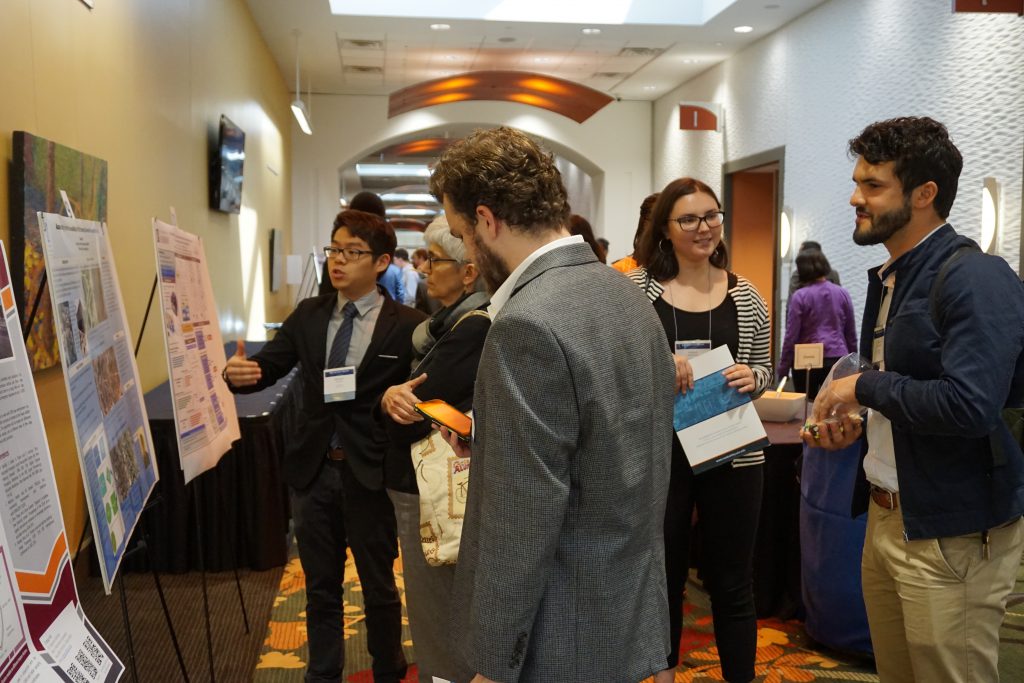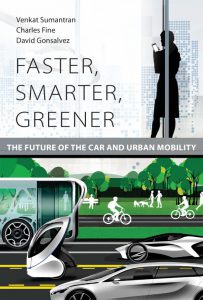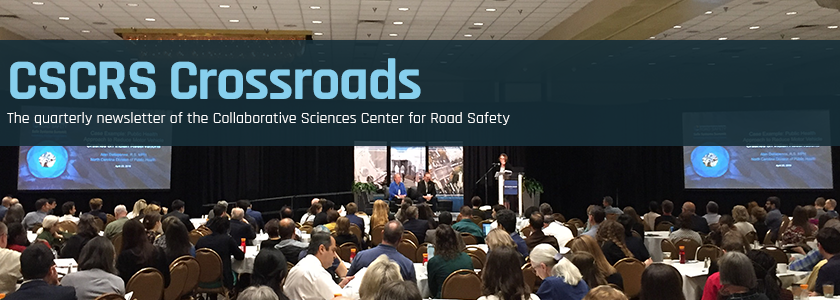Safe Systems Summit convenes hundreds to pave new path to safer roadways

In April 2019, CSCRS and the North Carolina Governor’s Highway Safety Program hosted the Safe Systems Summit: Redefining Transportation Safety, a two-day conference held in Durham, N.C., devoted to exploring the changing nature of traffic safety challenges. More than 340 participants gathered to share and develop a stronger understanding of the principles of Safe Systems and systems science that frame new efforts to reduce traffic injuries and fatalities.
Explore this recap page for more event details — including photos, videos and PDFs of presentations — that highlight the variety of topics and learning opportunities provided at the Summit. A special “CSCRS on the Streets” video project featured interviews about autonomous vehicles with students, children, retirees, law enforcement, college professors and others.
Calling all Safe Systems movers and shakers: If you attended the Summit, we’re excited to hear examples of how you’ve implemented or used Safe Systems in your work. Please send real-world examples and feedback to info@roadsafety.unc.edu with the subject line “Systems at work.”
Thank you to our Safe Systems Summit sponsors, whose support helped make the meeting possible:
Presenting Sponsors
Champion Level
Patron Level
Advocate Level
Supporter Level
Next CSCRS national event: NaTMEC
 Save the date for NaTMEC (National Travel Monitoring Exposition and Conference) 2020, to be held June 1-4, 2020, in Raleigh, N.C. The NaTMEC call for abstracts is now open; practitioners, researchers and students are invited to submit presentation abstracts for consideration by Sept. 23, 2019. The theme of the event is Connecting Travel Monitoring to Transportation System Safety and Mobility.
Save the date for NaTMEC (National Travel Monitoring Exposition and Conference) 2020, to be held June 1-4, 2020, in Raleigh, N.C. The NaTMEC call for abstracts is now open; practitioners, researchers and students are invited to submit presentation abstracts for consideration by Sept. 23, 2019. The theme of the event is Connecting Travel Monitoring to Transportation System Safety and Mobility.
CSCRS is coordinating the planning for the event, with support from the Federal Highway Administration. Stay tuned for other updates on the NaTMEC site.
Five CSCRS research projects now complete, explore systems principles, technology and data
CSCRS researchers have completed five research projects investigating how vehicle technology, planning policies and data analytics can provide systemic solutions to pedestrian-vehicle conflicts, and examining Safe Systems principles and lessons domestically and internationally. Check out final project details and reports on individual project pages:

- Structures of Stakeholder Relationships in Making Road Safety Decisions; Principal Investigator – Seth LaJeunesse, UNC Highway Safety Research Center
- Implementing Safe Systems in the United States: Guiding Principles and Lessons from International Practice; Principal Investigator – Eric Dumbaugh, Florida Atlantic University
- Completing the Picture of Traffic Injuries: Understanding Data Needs and Opportunities for Road Safety; Principal Investigator – Chris Cherry, University of Tennessee, Knoxville
- Identifying the Traffic Safety Information Needs of Major Cities in the U.S.; Principal Investigator – Eric Dumbaugh, Florida Atlantic University
- Using Advanced Analytics to Frame Vulnerable Road User Scenarios with Autonomous Vehicles; Principal Investigator – Noreen McDonald, UNC Department of City and Regional Planning
New products from other CSCRS projects that are almost completed have also been released:
- The project Strengthening Existing and Facilitating New Vision Zero Plans, led by researcher Kelly Evenson of the UNC Gillings School of Global Public Health, produced a library of U.S. Vision Zero plans that helps guide strategies to reduce traffic fatalities and injuries, while increasing safe, equitable and healthy mobility.
- The project Creating a CSCRS Clearinghouse for Bicyclist and Pedestrian Safety-Related Data, Phase I: Inventory & Framework, led by Krista Nordback of the UNC Highway Safety Research Center, created the National Pedestrian and Bicycle Safety Data Clearinghouse, a resource to help pedestrian and bicycle safety researchers find U.S. collision, count and infrastructure data.
The latest information on completed and current research can be found on the CSCRS Research Projects page. In addition, these projects, as well as other U.S. Department of Transportation University Transportation Center (UTC) sponsored projects, are listed in theTransportation Research Board’s Research in Progress (RiP) Database and Dataverse.
Education and professional development: quarterly review
In addition to the Safe Systems Summit, CSCRS has engaged students and professionals in a variety of other learning activities over the last several months:

- Graduate student CSCRS Road Safety Fellows at the University of California, Berkeley, launched an Autonomous Vehicles + Safety Roundtable in February 2019 to present work on the topic, as well as facilitate discussions on the potential and pitfalls of automated vehicle technology and deployment.
- In March 2019, CSCRS researchers met with UNC Department of City and Regional Planning students from the Complete, Safe, Equitable Streets course to review their capstone projects.
- CSCRS researchers Wesley Kumfer and Seth LaJeunesse gave a hands-on roadway design demo using a prop city intersection at North Carolina A&T’s first ever Transportation Awareness Day in April 2019.
- Students at Chapel Hill High School toured the Duke Humans and Autonomy Lab (HAL) mobile command center van at their annual Tigerfest event in May 2019.
- The third season of CSCRS’s Coffee & Conversation at UNC wrapped up in May 2019; archived presentations are available on the program’s page.
- In June 2019, Wes Kumfer co-presented on the Institute of Transportation Engineers webinar “The Safe Systems Approach to Speed Management: An emerging safety trend in the US.” (Accessing the webinar requires purchase.)
- Students from NC A&T’s Summer High School Transportation Institute visited the HAL lab at Duke in July 2019 to learn about the facility’s robotics programs and to practice traffic safety activities led by CSCRS researchers. This is the second year students from this program have participated in these activities.
- A University of California, Berkeley, student created the video channel City Beautiful; several of the videos focus on transportation planning.
CSCRS highlights
A quick rundown of additional recent and upcoming CSCRS activities and recognitions:
- CSCRS has been featured as a spotlight on the U.S. Department of Transportation’s Federal Highway Administration Safety Culture and the Zero Deaths Vision page.
- The Bird e-Scooter company released a safety report in April 2019 that cited the CSCRS website as a source related to Safe Systems.
- Researcher Seth LaJeunesse visited Capitol Hill in May 2019 to discuss CSCRS’s Safe Systems work with U.S. Senate staffers.
- CSCRS Director Laura Sandt and Education & Outreach Programs Manager Caroline Mozingo attended the Council of University Transportation Centers Summer Meeting hosted by the Southern Plains Transportation Center in Norman, Okla., in June 2019. (Meeting presentations are available online.)
- The Transportation Research Board Executive Committee named HSRC’s Wes Kumfer and Libby Thomas as this year’s winners of the Patricia F. Waller Award for their paper “Midblock Pedestrian Crash Predictions in a Systemic, Risk-Based Pedestrian Safety Process.” This award is given each year for the best paper in the area of safety and system users. (Laura Sandt and HSRC researcher Bo Lan were co-authors.)
- CSCRS Associate Director Noreen McDonald, UNC Department of City and Regional Planning, was recently appointed to the Council of University Transportation Center’s Executive Committee.
Safe systems and road safety news beyond CSCRS
- The National Safety Council released this policy statement on Safe Systems for road safety.
- The United Nations Road Safety Collaboration Academic Expert Group compiled a set of recommendations for a road safety strategy for the decade of 2020-2030.
- A new Insurance Institute for Highway Safety study shows that protected bike lanes vary in terms of injury risk.
- Uber ATG released its Self-Driving Vehicle Safety Case Framework.
CSCRS bookshelf
“Faster, Smarter, Greener: The Future of the Car and Urban Mobility,” Venkat Sumantran, Charles Fine and David Gonsalvez (2017), MIT Press
By Mojdeh Azad
Mojdeh Azad is a Ph.D. student in the Department of Civil and Environmental Engineering Transportation Engineering & Science Program at the University of Tennessee, Knoxville.

Venkat Sumantran and his co-authors, Charles Fine and David Gonsalvez, described the evolution of technology and changes related to the mobility industry in their book “Faster, Smarter, Greener: The Future of the Car and Urban Mobility.” In their view, “the future of mobility will be Connected, Heterogeneous, Intelligent, and Personalized (CHIP).” The authors walk readers through the process of the CHIP framework development by first discussing the current changes in mobility and urbanization and why the architecture of future mobility should be different than the existing situation. In the second part, they highlight the innovative responses that contribute to finding solutions to the mobility challenges, such as autonomous vehicles, sustainable mobility and innovative business models which form the building blocks of CHIP mobility architecture. In the last part, the authors develop the CHIP mobility framework and discuss the strategies to facilitate its implementation by identifying the roles of key stakeholders.
I found this book, written by the authors who are associated with both industry and academia, a valuable source of information that connects technological advances, economic activities and sustainable mobility solutions and transportation management strategies to envision a better mobility system and readers from various disciplines might find of interest.
CSCRS Crossroads newsletters are archived here.






